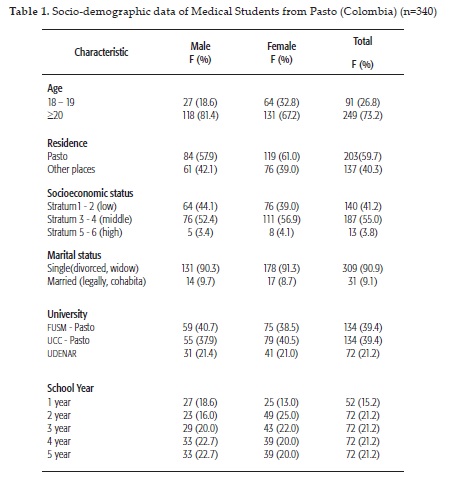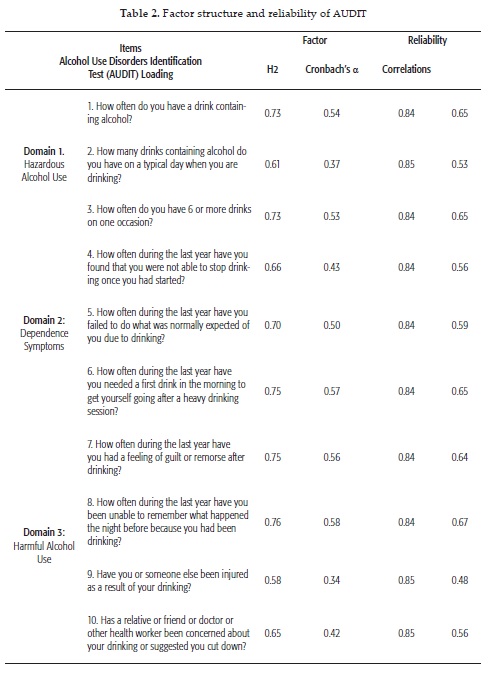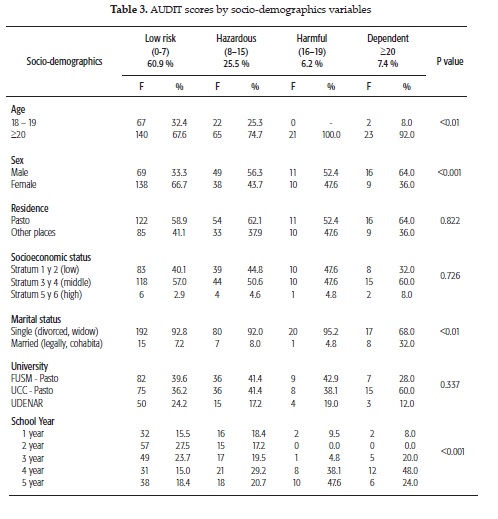Services on Demand
Journal
Article
Indicators
-
 Cited by SciELO
Cited by SciELO -
 Access statistics
Access statistics
Related links
-
 Cited by Google
Cited by Google -
 Similars in
SciELO
Similars in
SciELO -
 Similars in Google
Similars in Google
Share
Revista Salud Uninorte
Print version ISSN 0120-5552On-line version ISSN 2011-7531
Salud, Barranquilla vol.31 no.3 Barranquilla Sep./Dec. 2015
https://doi.org/10.14482/sun.31.3.5800
http://dx.doi.org/10.14482/sun.31.3.5800
Alcohol consumption among college medical students in Pasto (Colombia)
Consumo de alcohol en estudiantes de medicina en Pasto (Colombia)
Camilo Andrés Gaviria-Criollo1, Diego Alexander Martínez-Porras2, Andrés Fernando Arboleda-Castillo3, Ana Cristina Mafla4
1-3 Undergraduate medical student, School of Medicine Fundación Universitaria San Martín, Pasto (Nariño, Colombia).
4 DDS, MPH. Research Professor, School of Medicine Fundación Universitaria San Martín, Pasto (Nariño, Colombia).
Corresponding author: Ana Cristina Mafla, Research Professor. Address: Calle 18A n° 41-61. Pasto (Nariño, Colombia). Phone number: 57-27-314691. Fax number: 57-27-314697. ana.maffla@gmail.com
Fecha de recepción: 26 de julio de 2015
Fecha de aceptación: 11 de septiembre de 2015
Abstract
Objective: To evaluate the reliability of the Spanish version of the AUDIT and assess the rate of problematic alcohol consumers and associated risk factors among medical students in Pasto (Colombia).
Materials and Methods: A cross-sectional study was carried out in a random sample of 340 medical school students. All subjects were interviewed by two trained researchers. According to socio-demographic characteristics, variables such as age, sex, residence, socioeconomic status (SES), marital status, and study year were included. The 10-item Alcohol Disorder Identification Test (AUDIT) was used for assessing alcohol consumption. The inter-item correlations and Cronbach's α coefficient were calculated as measures of the internal consistency of the AUDIT.
Results: Factor analysis for the AUDIT items supported a single factor solution, with an eigenvalue of 4.8. Using a cut-off score of 8 for the AUDIT analysis indicated 39.1 % had problematic drinking (52.4 % men and 28.2 % women). There were significant statistical differences according to socio-demographics variables such as age, sex and study year.
Conclusion: The AUDIT principal component analysis resulted in a single-factor solution. The estimated occurrence of problematic drinking was high in these medical students. In terms of risk factors, variables such as age, sex and study year were related to higher scores. Preventive programs are needed to educate students about the risks associated to alcohol use.
Keywords: cross-sectional studies, alcohol drinking, medical students, severity of illness index, reproducibility of results, risk factors
Resumen
Objetivo: Evaluar la fiabilidad de la versión española del AUDIT y valorar el porcentaje de consumidores problemáticos de alcohol y factores de riesgo asociados en estudiantes de Medicina en Pasto (Colombia).
Materiales y métodos: Se realizó un estudio transversal en una muestra aleatoria de 340 estudiantes de Medicina. Todos los sujetos fueron entrevistados por dos investigadores entrenados. De acuerdo a las características sociodemográficas, se incluyó variables como la edad, sexo, residencia, nivel socioeconómico (SES), estado civil y año de estudio. La prueba de identificación de trastornos por alcohol (AUDIT) de 10 ítems fue usada para evaluar el consumo de alcohol. Las correlaciones inter-ítem y el coeficiente α de Cronbach se calcularon como medidas de consistencia interna del AUDIT.
Resultados: El análisis para los ítems del AUDIT mostró una estructura uni-factorial, con un eigenvalue de 4,8. Utilizando un punto de corte de 8 en el análisis del AUDIT indicó que 39,1 % tenía un consumo problemático (52,4 % hombres y 28,2 % mujeres). Existieron diferencias estadísticas significativas según variables sociodemográficas como edad, sexo y año de estudio. Conclusión: El análisis de componentes principales del AUDIT mostró una estructura unifactorial. La ocurrencia estimada de consumo problemático fue alta en estos estudiantes de Medicina. En términos de factores de riesgo, variables como la edad, el sexo y el año de estudio se relacionaron con puntuaciones más altas. Son necesarios programas de prevención para educar a los estudiantes acerca de los riesgos del uso del alcohol.
Palabras clave: estudios transversales, consumo de bebidas alcohólicas, estudiantes de medicina, índice de severidad de la enfermedad, reproducibilidad de resultados, factores de riesgo.
Introduction
Drawing on various studies, including WHO's Global Burden of Disease project, alcohol consumption is the fifth leading cause of death and disability worldwide (1). A China National Youth Risk Behavior Survey showed current drinkers represent 49.3 % (2). In 2011, in Kenya was found a lifetime prevalence rate of 51.9 % in College students (3). In Colombia, South America, the results of the 2001 RUMBOS Government Program National Survey showed 89.7 % of these students were regular alcohol consumers (4). Furthermore, in our city, Pasto (Nariño), occasional alcohol consumption in 19-29-years-olds individuals accounted for 74.1 %(5). College students in many countries are at elevated risk for heavy drinking, with serious immediate health risks, such as drink-driving and other substance use; and longer term risks, such as alcohol dependence (6).
Pasto is a small town close to the border between Colombia and Ecuador where there is special trade agreements. As a result of this some problems could emerge, one of them is younger people may access easily to illegal products such as cigarettes, energy drinks, different sort of liquors and special liquor craft named “chapil”. It is a beverage with high amount of alcohol content (40-60 % approximately). Borders show a different social dynamic because of a special environment is created by each sector of the border between two countries. Being alcoholism one of major social, economic and public health problem all over the world, territories located in this zone might be at risk and should be controlled more effectively.
The Alcohol Use Disorders Identification Test (AUDIT) is used to identify persons with hazardous and harmful patterns of alcohol consumption. It was developed by the World Health Organization (WHO) as a simple method of screening for excessive drinking and to assist in brief assessment (7, 8). The AUDIT is a valid and reliable questionnaire to detect problem drinkers in different cultures (9, 10). However, there are few studies about AUDIT reliability and hazardous and harmful drinking disorders in Pasto (Colombia). In this sense, the aim of this study was to evaluate the reliability of the Spanish version of the AUDIT and assess the rate of problematic alcohol consumers and associated risk factors among medical students in our locality.
Materials and methods
Study and Sample
A cross-sectional study was carry out in a random sample of 340 medical school students. All subjects were interviewed by two trained researchers. According to socio-demographic characteristics, variables such as age, sex, residence, socioeconomic status (SES), marital status, and study semester were included. Residence was defined as the main place of dwelling or home; “socioeconomic status” was evaluated in accordance with Colombia Government classification (stratum 1-2 = low, stratum 3-4= middle, and stratum 5-6= high) and “marital status” was defined as being alone or being in a couple. We included male and female medical students at three universities from Pasto (Colombia) and we excluded individuals under 18 years-old. Informed consent was obtained from the participating students.
Alcohol consumption
The 10-item Alcohol Disorder Identification Test (AUDIT) was used for assessing alcohol consumption, symptoms of alcohol dependence and problems associated with alcohol use. Responses to items on the AUDIT are rated on a 4-point Likert scale from 0 to 4, for a maximum score of 40 points. Higher AUDIT scores indicate more severe levels of risk; scores 8 or more indicate a tendency to problematic drinking.
Statistical analysis
Data were analyzed using Statistical Package for the Social Sciences (S.P.S.S) for Windows software application program version 17.0. Frequencies, means, standard deviations, were calculated to describe the sample. The inter-item correlations and Cronbach's α coefficients were calculated as measures of the internal consistency of the AUDIT.
Ethical Issues
Ethics approval Ethics approval for this study was granted by the Fundación Universitaria San Martín, Medical School Research and Ethics Committee (Act. n° CIET-CEI 003/2011). Written consent was obtained from all students prior to participation in the study.
Results
The sample consisted of 145 (42.6 %) men and 195 (57.4 %) women with a mean age of 21.6 years ± 2.9. Ninety point nine percent of college students were single (divorced or widow). Approximately 60 % of the sample lived in Pasto (Nariño). With regard to socioeconomic status, 55.6 % students belonged to middle class (table 1).
Factor Structure. Factor analysis was conducted using data from students who reported or not alcohol consumption. Results of the exploratory factor analysis for the AUDIT items supported a single factor solution, with an eigenvalue of 4.8. All items loaded > 0.58 on the first factor.
Reliability. Internal consistency of the screening measures was evaluated using the data from the 340 students who reported or not alcohol consumption. These analyses yielded strong evidence of internal consistency reliability for the AUDIT (Cronbach's α = 0.86, correlations ranged from 0.48-0.67) (table 2).
The mean total AUDIT score for the sample was 7.7 (SD = 7.38). Scores ranged from 0 to 40 with a median score of 6. Table 3 shows the distribution of total AUDIT scores. Sixty point nine percent of the sample were in the low risk range (33.3 % of men and 66.7 % of women), twenty five point six percent were at risk of hazardous alcohol consumption, 6.2 % were at risk of harmful and seven point four were at risk of alcohol dependence (64 % of men and 36 % of women).
Alcohol Use
Using a cut-off score of 8for the AUDIT analysis indicated 39.1 % has problematic drinking (52.4 % men and 28.2 % women). Moreover, 7.4 % of all men and women met criteria for probable alcohol dependence (with an AUDIT score of 20 or more) as defined by AUDIT. Men had significantly higher AUDIT scores than women in alcohol use (see table 3). There were statistical differences according to socio-demographics variables such as age, sex, marital status and school year.
Discussion
Problematic alcohol consumption among early adulthood individuals has leaded to numerous biological and psychosocial damages. Moreover, alcohol use disorders accounts for 9.6 % (7.7-11.8) of DALYs caused by mental and substance use disorders(11) and the harmful use of alcohol results in the death of 2.5 million people each year (12). For this reason, monitoring the behavior of alcohol consumption is mandatory in order to prevent and control the community´s health.
The AUDIT is a tool developed by the World Health Organization (WHO) as a simple method of screening for excessive drinking as the cause of a presenting illness. AUDIT has a high level of internal consistency and high reliability in relation to clinical diagnosis. The overall Cronbach's α of AUDIT in Spanish version was 0.86 in this sample. This value is in accord with findings from other reports of different language versions and populations, where yielded a comparable median reliability coefficient of 0.83, with a range of 0.75 to 0.97 (13, 14). Confirmatory factor analysis, using the whole sample, showed that our data fit well to a single-factor model originally suggested with an eigenvalue of 4.8.
Our outcomes state 39.1 % individuals among them 52.4 % men and 28.2 % women had a problematic drinking. The estimated occurrence differed from other general sample groups. For example, the prevalence of alcohol use in Southern Brazil was 18.4% which was higher among men (29.9 %) than in women (9.3 %) (15). Further, Kumar et al. (16) in a rural zone in Tamil Nadu, India revealed 9.4 % had this problematic condition. Regarding, medical group samples, Joos et al. (17) and Dahlin et al. (18) mentioned that 18 % of specialists in Belgium and 28 % of students in Sweden have been classified as hazardous drinkers while in our research students accounted for 25.5 %.
The alcohol consumption was more prevalent in equal or more than 20 year-old students. Young adulthood represents a genuine developmental phase in the life cycle. In its transitional position it shares many traits with the developmental process in youth and adulthood. This stage is characterized by establishing a secure personal identity, forming mature friendships and mature intimate relationships, reorientation of family ties, building up a core of ideological values, selecting a long-term vocation, finding one's bearings and looking to the future. This period still approach the perspective of “normative crisis” vs “continuous transformation” which may generate instability.
Alcohol consumption is much more commonplace among men in developed and undeveloped countries. Biological evidence suggests that women are more sensitive to the physiological effects of alcohol than men. It has long been recognized that a given dose of alcohol results in a higher blood-alcohol level in women than in men and it is thought that this is one reason why women suffer more physical harm from drinking the same amount of alcohol as men (19). In other words, women are much more susceptible than men to adverse consequences of alcohol use being a reason to drink lower levels of alcohol than men do.
Students increased their alcohol consumption in the 4 year of the school. It is widely acknowledged that university students experience high levels of stress due to intensive academic workloads, the knowledge base required, and the perception of having inadequate time to achieve it (20) and they may drink alcohol regularly in an attempt to relieve stress. However, in this year the students already overcome many adversities in their academic life since they have developed more professional skills. For this reason, students may have a more active social life. Unfortunately there aren't special programs in the University offering alternative entertainment activities to control the students' leisure time.
Conclusion
The AUDIT principal component analysis resulted in a single-factor solution. A similar structure was also confirmed by the scientific literature. The estimated occurrence of problematic drinking was high in these medical students. In terms of risk factors, variables such as age, sex and academic year were related to higher scores. Preventive programs are needed to educate students about the risks associated to alcohol use.
Financial Support: This study was supported by the authors.
References
1. Grim D. Staggering toward a Global Strategy on Alcohol Abuse. Science 2008;320(5878):862-3. [ Links ]
2. Ji CY, Hu PJ, Song Y. The epidemiology of alcohol consumption and misuse among Chinese college students. Alcohol Alcohol 2012;47(4):464-72. [ Links ]
3. Atwoli L, Mungla PA, Ndung'u MN, Kinoti KC, Ogot EM. Prevalence of substance use among college students in Eldoret, western Kenya. BMC Psychiatry 2011;11:34. [ Links ]
4. Presidencia de la República. Ministerio de Salud. Programa RUMBOS. Estudio Nacional sobre uso y abuso de Alcohol y Consumo de Sustancias Psicoactivas. Bogotá: Ministerio de Salud; 2001. [ Links ]
5. Observatorio Departamental de Drogas de Nariño (ODDN). Consumo de drogas lícitas e ilícitas en el departamento de Nariño, 2006-2007. Pasto: Instituto Departamental de Salud de Nariño (IDSN); 2008. p. 1-10. [ Links ]
6. Karam E, Kypri K, Salamoun M. Alcohol use among college students: an international perspective. Curr Opin Psychiatry 2007;20(3):213-21. [ Links ]
7. Saunders JB, Aasland OG, Amundsen A, Grant M. Alcohol consumption and related problems among primary health care patients: WHO collaborative project on early detection of persons with harmful alcohol consumption- I. Addiction 1993;88(3):349-62. [ Links ]
8. Saunders JB, Aasland OG, Babor TF, de la Fuente JR, Grant M. Development of the Alcohol Use Disorders Identification Test (AUDIT): WHO Collaborative Project on Early Detection of Persons with Harmful Alcohol Consumption- II. Addiction 1993;88(6):791-804. [ Links ]
9. Alvarado ME, Garmendia ML, Acuña G, Santis R, Arteaga O. Assessment of the alcohol use disorders identification test (AUDIT) to detect problem drinkers. Rev Med Chil 2009;137(11):1463-8. [ Links ]
10. Moussas GI, Dadouti G, Douzenis A, Poulis E, Tselebis A, Bratis D, et al. Reliability and validity of the Greek version of the Alcohol Use Disorders Identification Test (AUDIT). Psychiatrike 2010;21(1):54-9. [ Links ]
11. Whiteford HA, Degenhardt L, Rehm J, Baxter AJ, Ferrari AJ, Erskine HE, et al. Global burden of disease attributable to mental and substance use disorders: findings from the Global Burden of Disease Study 2010. Lancet. 2013;382(9904):1575-86. [ Links ]
12. World Health Organization. Global Information System on Alcohol and Health (GISAH) [Online] [date of access: September 6, 2013]. Retrieved from URL: http://www.who.int/gho/alcohol/en/index.html. [ Links ]
13. Reinert DF, Allen JP. The alcohol use disorders identification test: an update of research findings. Alcohol Clin Exp Res 2007;31(2):185-99. [ Links ]
14. Ospina-Díaz JM, Manrique FG, Ariza Riaño NE. Confiabilidad y dimensionalidad del Cuestionario para Identificación de Trastornos Debidos al Consumo de Alcohol (AUDIT) en estudiantes universitarios de Tunja (Colombia). Salud Uninorte (Barranquilla, Col.) 2012;28 (2): 276-82. [ Links ]
15. Reisdorfer E, Büchele F, Pires RO, Boing AF. Prevalence and associated factors with alcohol use disorders among adults: a population-based study in southern Brazil. Rev Bras Epidemiol 2012;15(3):582-94. [ Links ]
16. Kumar S G, K C P, L S, E S, Vinayagamoorthy, Kumar V. Prevalence and Pattern of Alcohol Consumption using Alcohol Use Disorders Identification Test (AUDIT) in Rural Tamil Nadu, India. J Clin Diagn Res 2013;7(8):1637-9. [ Links ]
17. Joos L, Glazemakers I, Dom G. Alcohol use and hazardous drinking among medical specialists. Eur Addict Res 2013;19(2):89-97. [ Links ]
18. Dahlin M, Nilsson C, Stotzer E, Runeson B. Mental distress, alcohol use and help-seeking among medical and business students: a cross-sectional comparative study. BMC Med Educ 2011;11:92. [ Links ]
19. Ely M, Hardy R, Longford NT, Wadsworth ME. Gender differences in the relationship between alcohol consumption and drink problems are largely accounted for by body water. Alcohol Alcohol 1999;34(6):894-902. [ Links ]
20. Carveth JA, Gesse T, Moss N. Survival strategies for nurse-midwifery students. J Nurse Midwifery 1996;41(1):50-4. [ Links ]

















